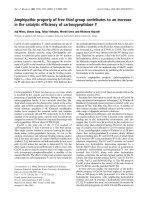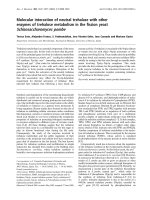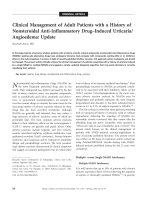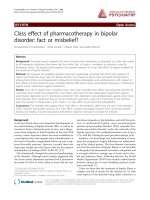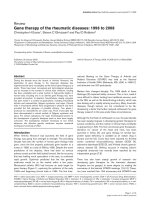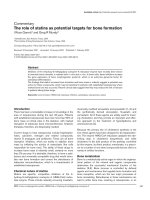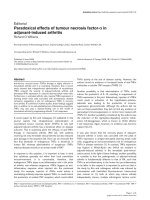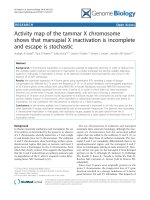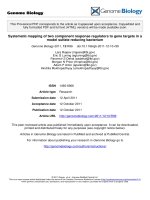Báo cáo y học: "Unusual presentation of hereditary neuropathy with liability to pressure palsies" pptx
Bạn đang xem bản rút gọn của tài liệu. Xem và tải ngay bản đầy đủ của tài liệu tại đây (231.02 KB, 6 trang )
BioMed Central
Page 1 of 6
(page number not for citation purposes)
Journal of Brachial Plexus and
Peripheral Nerve Injury
Open Access
Case report
Unusual presentation of hereditary neuropathy with liability to
pressure palsies
Muhammad U Farooq
1
, Jayne HW Martin
1
and Michael T Andary*
2
Address:
1
Department of Neurology and Ophthalmology, Michigan State University, East Lansing, MI, USA and
2
Department of Physical Medicine
and Rehabilitation, Michigan State University, College of Osteopathic Medicine, East Lansing, MI, USA
Email: Muhammad U Farooq - ; Jayne HW Martin - ;
Michael T Andary* -
* Corresponding author
Abstract
Background: Hereditary neuropathy with liability to pressure palsies (HNPP) is an autosomal-
dominant painless peripheral neuropathy characterized by episodes of repeated focal pressure
neuropathies at sites of entrapment/compression, with a considerable variability in the clinical
course. Electrodiagnostic and genetic testing are important in the diagnostic evaluation of these
patients.
Case presentation: We report an unusual HNPP phenotype, five compression neuropathies in
four nerves in a patient with bilateral hand numbness. A 42-year-old female, presented with acute
bilateral paresthesias and weakness in her hands after starting yoga exercises requiring
hyperextension of her hands at the wrists. Her presentation was complicated by: a) a remote
history of acute onset foot drop and subsequent improvement, b) previous diagnoses of
demyelinating peripheral neuropathy, possibly Charcot-Marie-Tooth disease, and c) exposure to
leprosy. Electrodiagnostic testing showed 5 separate compression neuropathies in 4 nerves
including: severe left and right ulnar neuropathies at the wrist, left and right median neuropathies
at the wrist and left ulnar neuropathy at the elbow. There was a mild generalized, primarily
demyelinating, peripheral polyneuropathy. Based on the clinical suspicion and electrodiagnostic
findings, consistent with profound demyelination in areas of compression, genetic analysis was done
which identified a deletion of the PMP-22 gene consistent with HNPP.
Conclusion: HNPP can present with unusual phenotypes, such as 5 separate mononeuropathies,
bilateral ulnar and median neuropathies at the wrists and ulnar neuropathy at the elbow with mild
peripheral demyelinating polyneuropathy associated with the PMP-22 gene deletion.
Background
Hereditary neuropathy with liability to pressure palsies
(HNPP) is an autosomal-dominant, painless peripheral
neuropathy characterized by episodes of repeated focal
pressure neuropathies at common sites of entrapment
and compression [1,2]. There is a considerable heteroge-
neity in phenotypes and clinical course of this disease.
Therefore electrodiagnostic, histopathologic, as well as
genetic testing are important in the diagnostic evaluation
of HNPP [3]. Electrophysiologically, HNPP is character-
Published: 24 January 2008
Journal of Brachial Plexus and Peripheral Nerve Injury 2008, 3:2 doi:10.1186/1749-7221-3-
2
Received: 30 November 2007
Accepted: 24 January 2008
This article is available from: />© 2008 Farooq et al; licensee BioMed Central Ltd.
This is an Open Access article distributed under the terms of the Creative Commons Attribution License ( />),
which permits unrestricted use, distribution, and reproduction in any medium, provided the original work is properly cited.
Journal of Brachial Plexus and Peripheral Nerve Injury 2008, 3:2 />Page 2 of 6
(page number not for citation purposes)
ized by a generalized demyelinating neuropathy, with
superimposed focal entrapment neuropathies [1,4]. There
are different genotypes including a 1.5 Mb deletion of
locus 17p11-2 (PMP-22 gene deletion). Pathologically,
tomaculae are seen on sensory as well as motor nerves
[5,6]. We report a novel phenotype of HNPP with PMP-22
gene deletion.
Case presentation
History and course
A 42-year-old female physician presented with bilateral
hand weakness, numbness, and tingling, in the right
greater than left upper extremity. The sensory symptoms
involved all fingers but were most prominent in the ulnar
distribution. She noted bilateral hand weakness and was
not able to cross her fingers. These symptoms began the
day after starting yoga exercises, which required pro-
longed hyperextension of her hands at the wrists. Prior to
this acute presentation, after repeat questioning, she
acknowledged that she did have some nocturnal paresthe-
sias that were not bothersome.
She reported a history of peroneal neuropathy at the right
fibular head eight years prior to this episode, which pre-
sented with acute onset of foot drop and subsequent
improvement. She has had multiple exposures to leprosy
while living in India. She denied any rashes, or skin
lesions. She was seen by a physician 8 years prior to this
presentation and had been told she had a demyelinating
neuropathy and carpal tunnel syndrome (CTS). She never
underwent complete diagnostic work up, though she was
treated with B12 at that time. She, being a physician,
thought that she may have Charcot-Marie-Tooth disease,
but this had never been diagnosed. She had no family his-
tory of a similar problem.
Physical examination
She was a healthy female of normal physique with intact
memory, attention, orientation language and visual-spa-
tial function. Cranial nerves II-XII were intact. There was
normal tone in upper and lower extremities. Motor
strength was grade 5 in all the four extremities, with the
exception of mild to moderate weakness of her intrinsic
hand muscles (dorsal and palmar interosseous, abductor
digiti minimi; right greater than left) There was mild atro-
phy of intrinsic hand muscles on the right side. There was
no weakness of her thumb abductors, flexor digitorum
superficialis and flexor digitorum profundus. The strength
in her legs was normal including the peroneal muscula-
ture. There was decreased sensation to touch and pinprick
in the 4
th
and 5
th
digits of her right hand, and lateral side
of her right thigh. Deep tendon reflexes were normal with
flexor plantar responses bilaterally. Cerebellar function
and gait exam were normal.
Laboratory work up
Extensive work up for neuropathy including but not lim-
ited to routine blood tests, HbA1c, erythrocyte sedimenta-
tion rate, thyroid stimulating hormone, vitamin E,
vitamin B12, creatinine kinase, anti-nuclear antibodies,
and rheumatoid factor was negative.
Electrodiagnostic studies
She had two electromyographic (EMG) studies done
within the interval of one week, first on the right and sec-
ond on the left side (see table 1, 2, 3, 4 for details). The
electrodiagnostic abnormalities were consistent with 5
different compression neuropathies in only 4 nerves:
1. Left median neuropathy at the wrist
2. Right median neuropathy at the wrist
3. Right ulnar neuropathy at the wrist
4. Left ulnar neuropathy at the wrist
5. Left ulnar neuropathy at the elbow
Additionally, there was an evidence of a mild generalized
primarily demyelinating peripheral polyneuropathy.
Based on the clinical suspicion and EMG findings leprosy
and HNPP were considered as possible diagnoses.
Genetic testing
The direct genetic testing for PMP-22 gene mutations was
performed by PCR amplification and automated sequenc-
ing of both genomic DNA strands for all exons coding for
the mature protein. The highly conserved exon-intron
splice junctions between exons were also examined.
Genetic analysis identified a deletion of the PMP-22 gene
consistent with HNPP.
Follow up course
The patient underwent right carpal tunnel and right
Guyon canal release procedures and her symptoms
improved post-operatively. She did not have any progres-
sion or new symptoms at her 6 month follow up visit at
our Neurology clinic. She declined further follow up.
Discussion
To our knowledge, this is the first case of HNPP presenting
with five separate simultaneous electrodiagnostically doc-
umented compression neuropathies. These include: bilat-
eral median and ulnar neuropathies at the wrist and ulnar
neuropathy at the elbow. In this case the ulnar neuropa-
thies were the most symptomatic. Her presentation was
complicated by the confounding variables of previous
diagnoses of "atypical" chronic inflammatory demyelinat-
Journal of Brachial Plexus and Peripheral Nerve Injury 2008, 3:2 />Page 3 of 6
(page number not for citation purposes)
ing polyneuropathy (CIDP) and exposure to leprosy,
which could present as a demyelinating polyneuropathy.
The electrodiagnostic evidence for each of the compres-
sion neuropathies is included below.
• Right median neuropathy at the wrist
a) prolonged absolute motor DL to APB (14.1 msec); b)
prolonged absolute motor DL to lumbrical (13.9 msec);
and c) absent SNAP to D2; d) comparative slowing of
median motor DL to the ABP (14.1 msec) when compared
to ulnar motor DL to ADM (5.0 msec); e) comparative
slowing of median motor DL to the lumbrical (13.9 msec)
when compared to ulnar motor DL to ADM (5.0 msec).
• Left median neuropathy at the wrist
a) prolonged motor DL to APB (13.6 msec); b) absent
SNAP to D2; c) large latency difference between median
(13.6 msec) and ulnar motor DL (4.2 msec) recorded
from the thenar muscles (median much slower).
Table 1: Sensory, motor nerve conduction studies and late responses (Right)
Nerve Stimulation Site Record Amplitude (mV) DL (msec) CV (m/sec)
Sensory nerve conduction studies
Median Wrist/midpalm D2 Absent Absent -
Ulnar Wrist D5 Absent Absent -
Sural Calf Ankle 18 4.1 14
Motor nerve conduction studies
Ulnar Wrist Thenar 1.1 4.5
Ulnar Wrist ADM 3.5 5.0
Ulnar Below Elbow ADM 3.5 8.0 51
Ulnar Above Elbow ADM 3.5 10.3 53
Ulnar Wrist FDI 2.3 6.1
Ulnar Below Elbow FDI 1.8 9.2 41
Ulnar Above Elbow FDI 1.7 12.1 48
Ulnar Wrist Interosseous 0.3 7.0
Median Wrist Lumbrical 0.4 13.9
Median Wrist APB 4 14.1
Median Elbow APB 4 18.9 46
Tibial Ankle AH 14 5.7
Tibial Knee AH 10 13.4 46
Peroneal Ankle EDB 5.9 6.3
Peroneal Below knee EDB 5.5 12.5 43
Peroneal Above knee EDB 5.4 14.2 54
Late responses
Ulnar F wave Wrist ADM 34.3
Tibial F-wave Ankle AH 51.7
Peroneal F-wave Ankle EDB 49.7
Tibial H reflex Knee Soleus 4 28.6
Table 2: Needle Electromyography (Right)
Muscle IA Fibrillation Effort Recruitment Polyphasia
Deltoid N 0 N N N
Biceps N 0 N N N
Pronator Teres N 0 N N N
EDC N 0 N N N
Triceps N 0 N N N
FCU N 0 N N N
FCR N 0 N N N
APB N 0 N N N
1
st
DIM Sustained 2+ N Decreased N
ADM Sustained 3+ N Decreased N
Anterior Tibialis N 0 N N N
Extensor Hallucis N 0 N N N
Gastroc/Soleus N 0 N N N
Journal of Brachial Plexus and Peripheral Nerve Injury 2008, 3:2 />Page 4 of 6
(page number not for citation purposes)
• Right ulnar neuropathy at the wrist
a) prolonged absolute motor DL to ADM (5.0 msec); b)
low amplitude to ADM (3.5 mV); c) prolonged absolute
motor DL to FDI (6.1 msec); d) low amplitude to FDI (2.3
mV); e) mildly prolonged ulnar absolute motor DL (4.5
msec) to thenar; f) absent SNAP to D5; g) abnormal nee-
dle EMG in the ulnar hand muscles with spared ulnar
forearm muscles.
• Left ulnar neuropathy at the wrist
a) prolonged absolute motor DL to ADM (5.4 msec); b)
mildly prolonged absolute ulnar motor DL to thenar (4.2
msec); c) prolonged absolute sensory DL to D5 (5.5
msec); d) low amplitude ulnar SNAP to D5 (5 micro-
volts), (Note: this could also be due to ulnar neuropathy
at elbow); e) abnormal needle EMG to FDI, (Note: this
could also be due to ulnar neuropathy at elbow).
• Left ulnar neuropathy at the elbow
a) slowed absolute NCV across the elbow, (34 m/sec); b)
drop of NCV from the forearm (55 m/sec) compared to
elbow (34 m/sec).
• Mild generalized primarily demyelinating PPN
a) prolonged absolute radial sensory DL (4.2 msec over 10
cm); b) prolonged absolute right sural sensory DL (4.1
msec); c) slightly prolonged absolute right peroneal DL to
EDB (6.3 msec); d) prolonged absolute left sural sensory
DL (5.0 msec); e) slightly prolonged absolute left pero-
neal DL to EDB (6.5 msec).
The weakness and sensory symptoms were most consist-
ent with bilateral ulnar neuropathies superimposed on
possible bilateral CTS and peripheral polyneuropathy of
unclear etiology. The polyneuropathy was essentially
asymptomatic at the time of presentation but had been
symptomatic in the past. The less likely diagnoses were
bilateral brachial plexopathy, bilateral cervical radiculop-
athy or central nervous system problem.
Further history and electrodiagnostic testing, as men-
tioned above, were required to assist with reaching a final
diagnosis. Electrodiagnostic testing confirmed the pres-
Table 3: Sensory, motor nerve conduction studies and late responses (Left)
Nerve Stimulation site Record Amplitude (mV) DL (msec) CV (m/sec)
Sensory nerve conduction studies
Median Wrist/palm D2 Absent Absent -
Ulnar Wrist D5 5 5.5 14
Radial Wrist D1 4 4.3 14
Sural Calf Ankle 16 5.0 14
Motor nerve conduction studies
Ulnar Wrist Thenar 4.2 4.7
Ulnar Wrist ADM 4.0 5.4
Ulnar Below Elbow ADM 4.1 8.2 55
Ulnar Above Elbow ADM 4.3 11.5 34
Median Wrist APB 5.5 13.6
Median Elbow APB 5.5 19.1 44
Tibial Ankle AH 15.3 5.5
Tibial Knee AH 11.4 14.2 40
Peroneal Ankle EDB 4.8 6.5
Peroneal Below Knee EDB 4.3 12.3 45
Peroneal Above Knee EDB 4.5 14.3 46
Late responses
Tibial H reflex Knee Soleus 5 28.5
Tibial F wave Knee AH 50
Table 4: Needle Electromyography (Left)
Muscle IA Fibrillation Effort Recruitment Polyphasia
Deltoid N 0 N N N
Pronator Teres N 0 N N N
EDC N 0 N N N
Triceps N 0 N N N
FCU N 0 N N N
FCR N 0 N N N
FDP D4 D5 N 0 N N N
APB N 0 N N N
1
st
DI Manus N 2+ N Decreased Increased
Anterior Tibialis N 0 N N N
Abductor Hallucis N 0 N N N
Gastroc/Soleus N 0 N N N
Journal of Brachial Plexus and Peripheral Nerve Injury 2008, 3:2 />Page 5 of 6
(page number not for citation purposes)
ence of a demyelinating neuropathy, in addition to an evi-
dence of multiple compressive neuropathies. The etiology
for the demyelinating peripheral polyneuropathy was
unclear, though HNPP was thought to be logical in this
setting; leprosy neuropathy (Hansen's disease) or CIDP
were also possible, though less logical, in this case. The
previous chronic history and lack of skin rash made lep-
rosy unlikely. The improvement in her symptoms and
marked compression neuropathies made CIDP unlikely.
At this point genetic testing helped to reach the final diag-
nosis of HNPP.
The majority of the documented cases of HNPP with ulnar
nerve involvement, presented with nerve entrapment or
compressive neuropathy at elbow [1,2,4,7]. There are
multiple cases of HNPP presenting with CTS. However, to
the best of our knowledge, there is no reported case of 5
separate electrodiagnostically documented compression
neuropathies as the presentation of HNPP.
HNPP is a well documented autosomal dominant disor-
der characterized by recurrent pressure palsies typically
precipitated by minor trauma or compression, first
described by De Long in 1947[1,3,8]. In 1993 Chance et.
al. showed that HNPP was due to 1.5 Mb deletion in the
17p 11-2 region spanning the gene for peripheral myelin
protein 22 (PMP-22) [5]. The typical HNPP presentation
may also occur with small deletions and distinct muta-
tions rather than the 1.5 Mb deletion of the PMP22 gene
[1,2,5].
HNPP typically presents with symptoms in the form of
focal mononeuropathy involving median, ulnar, radial
and peroneal nerves [1,3]. Atypical presentations of
HNPP include acute multiple mononeuropathies in a ful-
minant manner, rapidly progressive peripheral nerve dys-
function, recurrent poly radiculopathies, plexopathies,
acute vocal cord and hypoglossal nerve paralysis, Charcot-
Marie-Tooth disease, atypical Guillain-Barre syndromes,
CIDP and motor neuron disease like picture [1,9-14].
HNPP has electrophysiological findings including: evi-
dence of focal axonal loss, diffuse sensory nerve conduc-
tion slowing, prolongation of distal motor latencies, with
relatively infrequent and minor reduction of motor nerve
conduction velocities [1,7,14,15]. Focal thickening of the
myelin sheath, also named tomacula, are the main his-
topathologic characteristic of HNPP on nerve biopsy
[6,15]. There are some unknown mechanisms in the
pathophysiology of the disease process because mechani-
cal factors exclusively cannot explain the recurrent nerve
palsies in all cases of HNPP [9].
Conclusion
HNPP can present with different and unusual pheno-
types. Our case presented with 5 separate compression
neuropathies. These include: bilateral ulnar and median
neuropathies at the wrist and an ulnar neuropathy at the
elbow in addition to a generalized primarily demyelinat-
ing peripheral polyneuropathy.
Abbreviations
ADM – Abductor digiti minimi; APB – Abductor polices
brevis; AH – Abductor hallucis; CV – Conduction velocity;
CTS – Carpel tunnel syndrome; FDI – First dorsal interos-
sei muscle; DL-Distal latency; D2 – 2
nd
digit; D4 – 4
th
digit;
D5 – 5
th
digit; EDB – Extensor digitorum brevis; EDC –
Extensor digitorum communis; FCU – Flexor carpi
ulnaris; FCR – Flexor carpi radialis; IA – Insertional activ-
ity; N – Normal; PPN – Peripheral polyneuropathy; SNAP
– Sensory nerve action potential.
Competing interests
The author(s) declare that they have no competing inter-
ests.
Authors' contributions
All of the authors of this manuscript participated in the
conception and design, acquisition of data, analysis and
interpretation of data, drafting of the manuscript, admin-
istrative, technical, and material support.
Acknowledgements
Written approval was obtained from Institutional Review Board (IRB) of
Michigan State University for publication of this case report. Written
informed consent was obtained from the patient for publication of this case
report.
References
1. Mouton P, Tardieu S, Gouider R, Birouk N, Maisonobe T, Dubourg
O, Brice A, LeGuern E, Bouche P: Spectrum of clinical and elec-
trophysiologic features in HNPP patients with the 17p11.2
deletion. Neurology 1999, 52:1440-1446.
2. Gouider R, LeGuern E, Gugenheim M, Tardieu S, Maisonobe T, Leger
JM, Vallat JM, Agid Y, Bouche P, Brice A: Clinical, electrophysio-
logic, and molecular correlations in 13 families with heredi-
tary neuropathy with liability to pressure palsies and a
chromosome 17p11.2 deletion. Neurology 1995, 45:2018-2023.
3. Paprocka J, Kajor M, Jamroz E, Jezela-Stanek A, Seeman P, Marszal E:
Hereditary neuropathy with liability to pressure palsy. Folia
Neuropathol 2006, 44:290-294.
4. Hong YH, Kim M, Kim HJ, Sung JJ, Kim SH, Lee KW: Clinical and
electrophysiologic features of HNPP patients with 17p11.2
deletion. Acta Neurol Scand 2003, 108:352-358.
5. Chance PF, Alderson MK, Leppig KA, Lensch MW, Matsunami N,
Smith B, Swanson PD, Odelberg SJ, Disteche CM, Bird TD: DNA
deletion associated with hereditary neuropathy with liability
to pressure palsies. Cell 1993, 72:143-151.
6. Madrid R, Bradley WG: The pathology of neuropathies with
focal thickening of the myelin sheath (tomaculous neuropa-
thy): studies on the formation of the abnormal myelin
sheath. 1975, 25:415-448.
7. Earl CJ, Fullerton PM, Wakefield GS, Schutta HS: Hereditary Neu-
ropathy, with Liability to Pressure Palsies; a Clinical and
Electrophysiological Study of Four Families. Q J Med 1964,
33:481-498.
Publish with BioMed Central and every
scientist can read your work free of charge
"BioMed Central will be the most significant development for
disseminating the results of biomedical research in our lifetime."
Sir Paul Nurse, Cancer Research UK
Your research papers will be:
available free of charge to the entire biomedical community
peer reviewed and published immediately upon acceptance
cited in PubMed and archived on PubMed Central
yours — you keep the copyright
Submit your manuscript here:
/>BioMedcentral
Journal of Brachial Plexus and Peripheral Nerve Injury 2008, 3:2 />Page 6 of 6
(page number not for citation purposes)
8. De Jong JGY: Over families met hereditaire dispositie tot het
optreden van neuritiden, gecorreleerd met migraine. Psychi-
atr Neurol BI 1947, 50:60-76.
9. Le Forestier N, LeGuern E, Coullin P, Birouk N, Maisonobe T, Brice
A, Leger JM, Bouche P: Recurrent polyradiculoneuropathy with
the 17p11.2 deletion. Muscle Nerve 1997, 20:1184-1186.
10. Lynch JM, Hennessy M: HNPP presenting as sciatic neuropathy.
J Peripher Nerv Syst 2005, 10:1-2.
11. Corwin HM, Girardet RE: Hereditary neuropathy with liability
to pressure palsies mimicking hypoglossal nerve injuries.
Neurology 2003, 61:1457-1458.
12. Ohkoshi N, Kohno Y, Hayashi A, Wada T, Shoji S: Acute vocal cord
paralysis in hereditary neuropathy with liability to pressure
palsies. Neurology 2001, 56:1415.
13. Crum BA, Sorenson EJ, Abad GA, Dyck PJ: Fulminant case of
hereditary neuropathy with liability to pressure palsy. Muscle
Nerve 2000, 23:979-83.
14. Horowitz SH, Spollen LE, Yu W: Hereditary neuropathy with lia-
bility to pressure palsy: fulminant development with axonal
loss during military training. J Neurol Neurosurg Psychiatry 2004,
75:1629-31.
15. Behse F, Buchthal F, Carlsen F, Knappeis GG: Hereditary neurop-
athy with liability to pressure palsies. Electrophysiological
and histopathological aspects. Brain 1972, 95:777-794.
